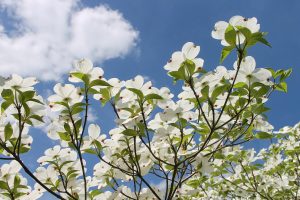The Amazon rainforest, a vast, verdant expanse that stretches across South America, is a true botanical wonderland – a living, breathing tapestry of life that has captivated the human imagination for centuries. From the towering canopy of ancient trees to the lush, tangled understory, this remarkable ecosystem is home to an astounding diversity of plant life, each species adapted to thrive in the rainforest’s unique and ever-changing environment. Join us as we journey into the heart of this living, breathing tapestry, and discover the captivating world of rainforest plants.
Brazil Nut Tree: The Treasure of the Amazon
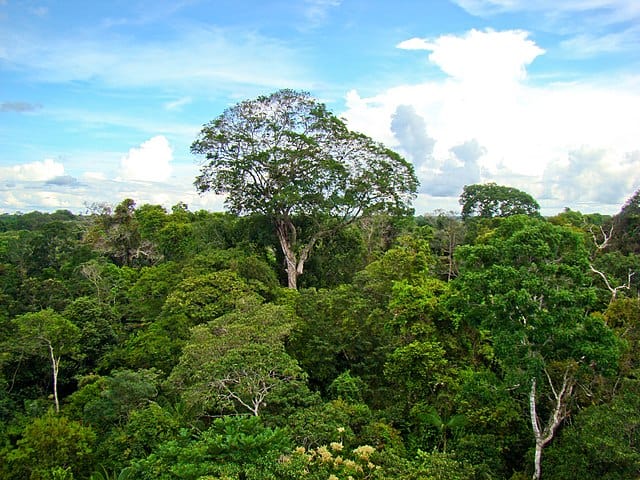
Towering up to 160 feet tall, the Brazil Nut Tree (Bertholletia excelsa) is a true giant of the rainforest canopy. Native to the Amazon basin, this majestic tree is renowned for its bountiful harvest of Brazil nuts, a beloved delicacy enjoyed worldwide. Each pod-like fruit, weighing up to 5 pounds, can contain up to 24 of these nutrient-dense nuts, making it a vital food source for both humans and wildlife.
Beyond its culinary significance, the Brazil Nut Tree plays a crucial role in the intricate web of the rainforest ecosystem. Its massive, buttressed roots help stabilize the soil, preventing erosion and providing a foundation for the surrounding vegetation. The tree’s flowers, with their distinctive burst of vibrant yellow, attract a diverse array of pollinators, including bees, butterflies, and hummingbirds, ensuring the continued regeneration of the forest.
Cocoa Tree: The Chocolate Treasure of the Tropics

Nestled within the shaded understory of the rainforest, the Cocoa Tree (Theobroma cacao) is the unassuming source of one of the world’s most beloved treats – chocolate. Native to the Amazon basin and Mesoamerica, this small, evergreen tree thrives in the warm, humid conditions of the tropics, producing pods filled with the precious cocoa beans that are the foundation of chocolate production.
The Cocoa Tree’s journey from pod to palate is a fascinating one, involving a complex process of fermentation, drying, and roasting to unlock the rich, complex flavors that have captivated taste buds for centuries. Beyond its culinary significance, the Cocoa Tree holds deep cultural and economic importance for the indigenous communities who have long cultivated and revered this remarkable plant.
Passion Flower: The Ethereal Beauty of the Rainforest

Cascading from the branches of rainforest vines, the Passion Flower (Passiflora) is a true sight to behold, with its intricate, otherworldly blooms that seem to defy the laws of nature. This genus of flowering plants, with over 500 species found worldwide, is particularly abundant in the tropical regions of the Americas, where it has long been celebrated for its beauty, medicinal properties, and cultural significance.
The Passion Flower’s unique and captivating appearance, with its crown-like array of delicate petals and intricate, intricate structures, has inspired countless legends and mythologies across cultures. From the indigenous peoples of the Amazon to the Spanish conquistadors, this plant has been revered for its symbolic representation of the Passion of Christ, as well as its potential therapeutic benefits, which include the treatment of anxiety, insomnia, and even seizures.
Orchids: The Jewels of the Rainforest
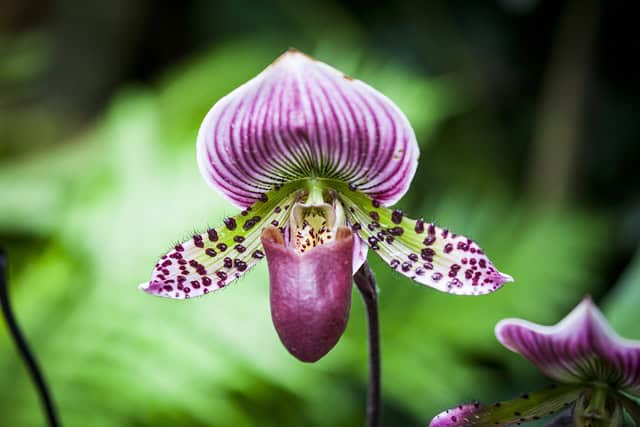
Amidst the lush, verdant canopy of the rainforest, a dazzling array of orchids flourish, their delicate blooms adorning the branches and trunks of towering trees. With an estimated 30,000 species, orchids are the largest family of flowering plants on Earth, and the rainforest is their undisputed domain.
These captivating plants have evolved a remarkable array of adaptations to thrive in the challenging conditions of the rainforest. Many orchid species are epiphytes, meaning they grow upon other plants without harming them, using their intricate root systems to cling to the bark and absorb nutrients and moisture from the air. Others have developed specialized pollination strategies, luring in a diverse array of insects and birds with their vibrant colors and alluring scents.
From the iconic Phalaenopsis, or Moth Orchid, to the rare and endangered Paphiopedilum, or Slipper Orchid, each species is a testament to the incredible diversity and resilience of these botanical marvels. As rainforests face increasing threats from deforestation and climate change, the preservation of these fragile ecosystems is crucial to ensuring the continued survival of these enchanting plants.
Lianas: The Botanical Climbers of the Rainforest
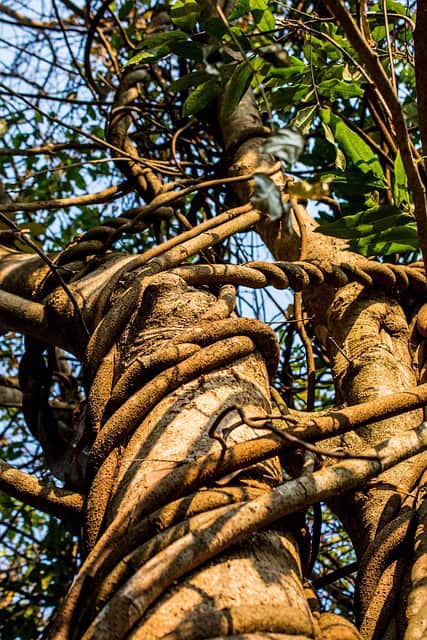
Winding their way through the dense foliage of the rainforest canopy, lianas are a remarkable group of woody vines that have adapted to thrive in these lush, dynamic environments. These botanical climbers, which can grow up to hundreds of feet in length, play a vital role in the intricate web of the rainforest ecosystem, providing food, shelter, and support for a diverse array of plant and animal species.
Lianas are known for their ability to quickly and efficiently climb to the upper reaches of the forest, using their flexible, twining stems to cling to the trunks and branches of towering trees. This strategy allows them to access the abundant sunlight and resources found in the canopy, while minimizing the need to invest in the costly construction of a self-supporting woody stem.
From the iconic Strangler Fig (Ficus), which can envelop and eventually kill its host tree, to the delicate, flowering Passion Vines (Passiflora), lianas are a testament to the incredible adaptability and resilience of rainforest plants. As these dynamic ecosystems face increasing threats, the preservation of lianas and their intricate relationships with other species is crucial to maintaining the overall health and balance of the rainforest.
Strangler Fig: The Botanical Conqueror of the Rainforest
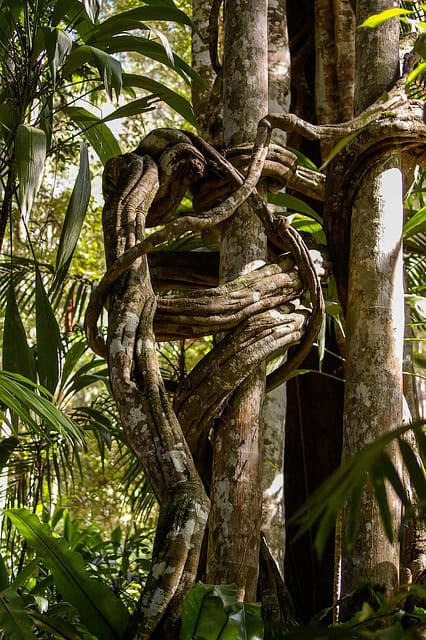
Amidst the lush, verdant canopy of the rainforest, a remarkable plant stands out, its sprawling, aerial roots enveloping the trunks of towering trees like a living, botanical embrace. This is the Strangler Fig (Ficus), a remarkable species of fig tree that has adapted to thrive in the competitive and resource-rich environment of the rainforest.
The Strangler Fig’s life cycle begins when its seeds, dispersed by birds or other animals, take root on the branches or trunks of other trees. As the fig seedling grows, it sends out a network of aerial roots that gradually descend towards the ground, eventually encircling and enveloping the host tree. Over time, the fig’s roots fuse and thicken, effectively strangling the host and cutting off its access to sunlight and nutrients.
This remarkable adaptation allows the Strangler Fig to quickly outcompete its neighbors, gaining access to the valuable resources of the canopy while minimizing the need to invest in the costly construction of a self-supporting trunk. The result is a towering, multi-trunked tree that can reach heights of over 200 feet, its sprawling branches providing shelter and sustenance for a diverse array of rainforest inhabitants.
Mahogany: The Prized Timber of the Tropics
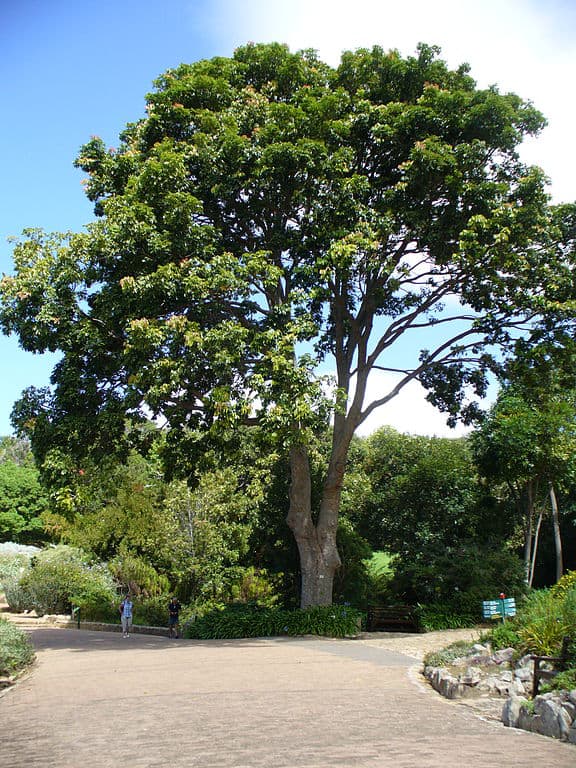
Towering up to 150 feet tall, the Mahogany (Swietenia) tree is a true giant of the rainforest, its rich, reddish-brown wood prized for its beauty, durability, and versatility. Native to the tropical regions of the Americas, Mahogany has long been a valuable resource for indigenous communities, who have used its timber for everything from furniture and musical instruments to canoes and ceremonial structures.
The Mahogany tree’s success in the rainforest can be attributed to its remarkable adaptations, including a deep, extensive root system that allows it to thrive in the nutrient-poor soils of the tropics. Its large, leathery leaves are also well-suited to the high-light conditions of the canopy, enabling the tree to efficiently capture and utilize the abundant sunlight.
Unfortunately, the Mahogany’s popularity and value have also made it a target for unsustainable logging practices, leading to the depletion of its populations in many regions. Conservation efforts, including the establishment of protected areas and the promotion of sustainable forestry practices, are crucial to ensuring the continued survival of this iconic rainforest species.
Hot Lips: The Vibrant Allure of the Rainforest

Nestled amidst the lush, verdant undergrowth of the rainforest, a splash of vibrant color catches the eye – the captivating blooms of the Hot Lips plant (Psychotria elata). This remarkable species, native to the tropical regions of Central and South America, is known for its striking, lipstick-red bracts that resemble a pair of sensual, parted lips, earning it the moniker “Hot Lips” among botanists and nature enthusiasts alike.
The Hot Lips plant’s remarkable appearance is more than just a visual delight; it serves a crucial ecological purpose. The plant’s bright, attention-grabbing bracts are designed to attract a specific pollinator – the long-billed hummingbird. As these agile, nectar-feeding birds visit the Hot Lips in search of sustenance, they inadvertently transfer pollen from flower to flower, ensuring the plant’s continued reproduction and the maintenance of the rainforest’s delicate pollination networks.
Beyond its ecological significance, the Hot Lips plant has also captured the imagination of people around the world, inspiring art, literature, and even the development of horticultural varieties for use in gardens and landscaping. As a testament to the incredible diversity and beauty of the rainforest, the Hot Lips plant continues to captivate and inspire all who encounter its vibrant, sensual blooms.
Achiote: The Natural Dye of the Rainforest

Amidst the vibrant tapestry of the rainforest, one plant stands out for its unique and versatile properties – the Achiote (Bixa orellana), also known as the Annatto or Lipstick Tree. This small, evergreen shrub, native to the tropical regions of the Americas, has long been prized by indigenous communities for its ability to produce a rich, reddish-orange dye that has been used for centuries in a wide range of applications.
The Achiote’s distinctive color comes from the plant’s seeds, which are encased in a spiny, reddish-brown pod. When these seeds are harvested and processed, they yield a natural pigment that has been used to color everything from textiles and cosmetics to food and even body paint. The Achiote’s dye is particularly prized for its ability to resist fading, making it a valuable resource for traditional artisans and craftspeople.
Beyond its use as a natural dye, the Achiote plant also has a rich history of medicinal and culinary applications. Its leaves and seeds have been used to treat a variety of ailments, from skin infections to digestive issues, while its pungent, slightly peppery flavor has made it a staple ingredient in many traditional Latin American dishes.
As the demand for natural, sustainable dyes and pigments continues to grow, the Achiote plant has gained renewed attention and appreciation, highlighting the incredible value and versatility of the rainforest’s botanical treasures.
Heliconia: The Tropical Torch of the Rainforest
![]()
Bursting forth from the lush, verdant undergrowth of the rainforest, the Heliconia (Heliconia spp.) is a true sight to behold, its vibrant, torch-like blooms adding a splash of color to the otherwise shaded forest floor. Native to the tropical regions of the Americas, this remarkable genus of plants is known for its diverse array of shapes, sizes, and hues, ranging from the iconic, red-and-yellow “Parrot’s Beak” to the more subdued, purple-and-green varieties.
The Heliconia’s striking appearance serves a crucial ecological purpose, attracting a wide range of pollinators, including hummingbirds, butterflies, and even small mammals, that feed on the plant’s nectar-rich flowers. This symbiotic relationship is essential to the overall health and balance of the rainforest ecosystem, as the Heliconia’s pollination ensures the continued regeneration of the forest.
Beyond its ecological significance, the Heliconia has also captured the imagination of people around the world, inspiring the development of horticultural varieties for use in gardens and landscaping. Its bold, tropical aesthetic has made it a popular choice for floral arrangements and cut-flower markets, further highlighting the incredible value and versatility of this rainforest plant.
Ironwood: The Resilient Giant of the Rainforest

Towering high above the lush, verdant canopy of the rainforest, the Ironwood (Lophira alata) is a true giant among its botanical brethren, its massive, buttressed trunk and dense, hardwood timber a testament to the incredible resilience and adaptability of this remarkable tree species.
Native to the tropical regions of West and Central Africa, the Ironwood is known for its exceptional durability and resistance to decay, making it a highly sought-after resource for a wide range of applications, from construction and furniture-making to the production of charcoal and firewood.
But the Ironwood’s value extends far beyond its practical uses; it is also a vital component of the rainforest ecosystem, providing food and shelter for a diverse array of wildlife, from birds and primates to insects and small mammals. The tree’s massive, spreading canopy offers shade and protection to the understory plants and animals, while its deep, extensive root system helps to stabilize the soil and prevent erosion.
Rubber Tree: The Botanical Bounty of the Rainforest

Amidst the lush, verdant canopy of the rainforest, one tree stands out for its remarkable ability to produce a valuable, versatile resource – the Rubber Tree (Hevea brasiliensis). Native to the Amazon basin, this towering, deciduous tree has long been prized for its ability to yield a milky, latex-rich sap that can be harvested and processed into a wide range of rubber-based products.
The Rubber Tree’s success in the rainforest can be attributed to its remarkable adaptations, including a deep, extensive root system that allows it to thrive in the nutrient-poor soils of the tropics. Its large, leathery leaves are also well-suited to the high-light conditions of the canopy, enabling the tree to efficiently capture and utilize the abundant sunlight.
For centuries, indigenous communities in the Amazon have tapped the Rubber Tree’s sap, using the resulting latex to create everything from waterproof clothing and footwear to tools and containers. The arrival of European explorers in the 19th century further fueled the demand for this valuable resource, leading to the establishment of large-scale rubber plantations and the rapid deforestation of the Amazon.
Today, the Rubber Tree remains an important agricultural crop, with plantations spanning across the tropics. However, the preservation of the rainforest’s wild Rubber Tree populations is crucial to maintaining the genetic diversity and resilience of this remarkable plant. Through sustainable harvesting practices and the protection of primary forest habitats, we can ensure that the Rubber Tree continues to thrive and provide its invaluable bounty to both local communities and the global economy.
Giant Water Lily: The Botanical Behemoth of the Rainforest

Floating serenely atop the still, mirror-like waters of the rainforest’s rivers and lakes, the Giant Water Lily (Victoria amazonica) is a true botanical marvel, its massive, circular leaves and stunning, fragrant blooms captivating all who behold them.
Native to the Amazon basin, this aquatic plant is known for its remarkable size, with leaves that can reach up to 10 feet in diameter and support the weight of a small child. The Giant Water Lily’s leaves are also remarkably buoyant, thanks to their intricate, rib-like structure and the presence of air pockets within the leaf tissue.
But the Giant Water Lily’s true splendor lies in its stunning, white-to-pink flowers, which open at night and release a sweet, fruity fragrance to attract their primary pollinators – nocturnal beetles. As these insects crawl across the lily’s broad, flat leaves in search of nectar, they inadvertently transfer pollen from flower to flower, ensuring the plant’s continued reproduction and the maintenance of the rainforest’s delicate aquatic ecosystems.
Despite its impressive size and beauty, the Giant Water Lily is a fragile and threatened species, with its populations facing a range of challenges, from habitat loss and pollution to the impacts of climate change. Through the establishment of protected wetland areas and the promotion of sustainable tourism and conservation efforts, we can work to safeguard this botanical wonder and ensure that it continues to captivate and inspire generations to come.
Bromeliads: The Botanical Architects of the Rainforest

Adorning the branches and trunks of the rainforest’s towering trees, the Bromeliads (Bromeliaceae) are a diverse and fascinating family of plants that have adapted to thrive in the challenging, resource-rich environment of the canopy.
These epiphytic plants, which include the iconic pineapple and the striking, vibrant-hued Tillandsia, or “air plants,” are known for their unique, rosette-like growth habit, which allows them to efficiently capture and store water and nutrients from the air and their host plants.
But the Bromeliads’ true ecological significance lies in their role as botanical architects, creating intricate, self-contained ecosystems within the rainforest canopy. The central cup-like structure of the Bromeliad’s leaves forms a natural reservoir that collects rainwater, leaf litter, and even the remains of small animals, providing a vital source of sustenance for a diverse array of invertebrates, amphibians, and even small mammals.
Banana Tree: The Staple Sustenance of the Rainforest
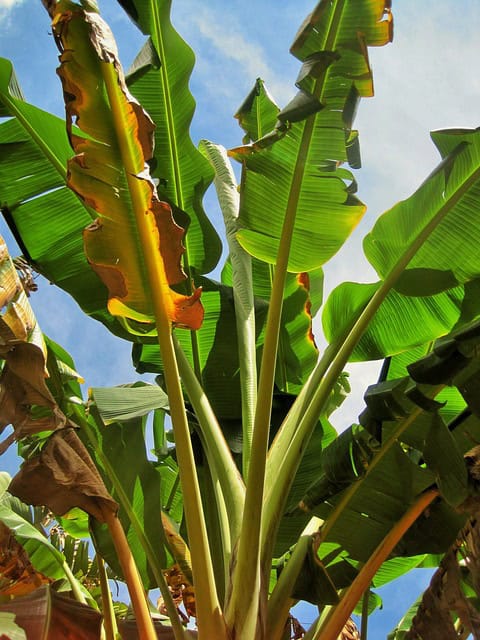
Towering up to 30 feet tall, with broad, paddle-shaped leaves and clusters of dangling, banana-laden inflorescences, the Banana Tree (Musa spp.) is a true icon of the rainforest, providing a vital source of sustenance for both human and animal inhabitants alike.
Native to the tropical regions of Southeast Asia, the Banana Tree has been cultivated and revered by indigenous communities for millennia, its starchy, nutrient-rich fruits serving as a dietary staple and a crucial component of traditional agricultural systems. In the rainforest, the Banana Tree’s deep, fibrous root system helps to stabilize the soil, while its broad leaves provide shade and shelter for a diverse array of understory plants and animals.
But the Banana Tree’s significance extends far beyond its role as a food crop; it is also a vital part of the rainforest’s intricate web of life. The tree’s flowers and fruits attract a wide range of pollinators and seed dispersers, including birds, bats, and primates, which in turn play a crucial role in maintaining the overall health and diversity of the ecosystem.
Açai Palm: The Superfood Sensation of the Rainforest
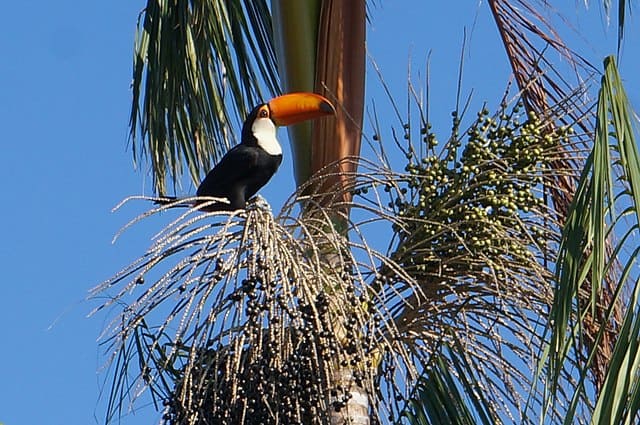
Towering up to 80 feet tall, with a slender, graceful trunk and a crown of feathery, pinnate leaves, the Açai Palm (Euterpe oleracea) is a true icon of the Amazon rainforest, its deep purple, berry-like fruits prized for their exceptional nutritional value and unique, tangy-sweet flavor.
Native to the floodplains and estuaries of the Amazon basin, the Açai Palm has long been a dietary staple for indigenous communities, who have relied on its nutrient-rich fruits as a source of sustenance and energy. In recent years, the Açai has gained global recognition as a “superfood,” with its high antioxidant content, healthy fats, and array of essential vitamins and minerals making it a sought-after ingredient in health-conscious diets and wellness products.
But the Açai Palm’s significance extends far beyond its culinary and nutritional value; it is also a vital component of the rainforest ecosystem, providing food and shelter for a diverse array of wildlife, from birds and primates to insects and small mammals. The palm’s deep, fibrous root system helps to stabilize the soil and prevent erosion, while its fronds and trunks offer valuable resources for traditional crafts and construction.
As the demand for Açai continues to grow, both within the Amazon region and around the world, the preservation of the rainforest’s Açai Palm populations has become increasingly crucial. Through sustainable harvesting practices, the promotion of agroforestry systems, and the establishment of protected areas, we can work to ensure that this remarkable plant continues to thrive and provide its invaluable bounty to both local communities and the global market.
Water Lettuce (Pistia stratiotes): The Floating Foliage of the Rainforest

Drifting serenely across the still, mirror-like waters of the rainforest’s rivers, lakes, and wetlands, the Water Lettuce (Pistia stratiotes) is a truly remarkable sight to behold. This floating, aquatic plant, with its broad, rosette-like leaves and delicate, feathery roots, is a vital component of the rainforest’s diverse and interconnected aquatic ecosystems.
Native to the tropical regions of Africa and Asia, the Water Lettuce has adapted to thrive in the nutrient-rich, slow-moving waters of the rainforest, where it plays a crucial role in maintaining water quality and providing food and shelter for a wide range of aquatic organisms. The plant’s broad, floating leaves offer shade and protection for small fish and invertebrates, while its roots serve as a natural filter, absorbing excess nutrients and helping to prevent the growth of harmful algal blooms.
Lupuna: The Towering Titan of the Rainforest

Soaring high above the lush, verdant canopy of the Amazon rainforest, the Lupuna (Ceiba pentandra) is a true botanical giant, its massive, buttressed trunk and sprawling, umbrella-like crown commanding the attention of all who behold it. This majestic, deciduous tree, native to the tropical regions of the Americas, is a vital component of the rainforest ecosystem, providing food, shelter, and resources to a diverse array of plant and animal life.
One of the most striking features of the Lupuna is its towering stature, with some individuals reaching heights of over 200 feet. This impressive size is made possible by the tree’s deep, extensive root system and its ability to efficiently capture and utilize the abundant sunlight that filters through the canopy. The Lupuna’s broad, flared buttresses also serve to stabilize the tree’s massive trunk, allowing it to withstand the strong winds and heavy rains that are characteristic of the rainforest environment.
But the Lupuna’s significance extends far beyond its physical presence; it is also a vital resource for the indigenous communities that call the Amazon home. The tree’s soft, lightweight wood has been used for centuries to craft a wide range of tools and implements, from canoes and furniture to musical instruments and ceremonial objects. The Lupuna’s fluffy, cotton-like seed fibers have also been used to create insulation and textiles, while the tree’s edible flowers and fruits have provided a valuable source of sustenance.
Camu Camu Plant (Myrciaria dubia): The Vitamin C Powerhouse of the Rainforest
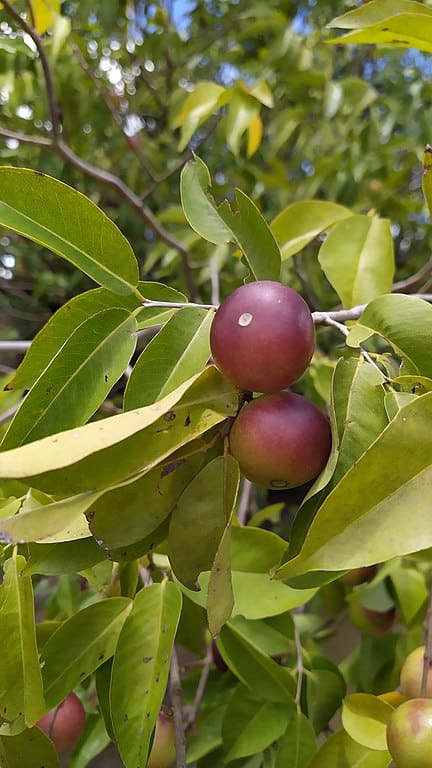
Tucked away in the dense, lush undergrowth of the Amazon rainforest, the Camu Camu plant (Myrciaria dubia) is a true botanical marvel, its small, tart-tasting berries packed with an astonishingly high concentration of vitamin C – up to 60 times more than an orange.
Native to the floodplains and riverbanks of the Amazon basin, the Camu Camu is a hardy, evergreen shrub that has adapted to thrive in the nutrient-rich, yet challenging, environment of the rainforest. Its deep, fibrous root system allows it to withstand the periodic flooding that is a hallmark of the region, while its small, glossy leaves and compact growth habit help it to compete for resources in the shaded understory.
But the Camu Camu’s true claim to fame is its exceptional nutritional profile, with its vitamin C-rich berries offering a wealth of health benefits. In addition to its potent antioxidant properties, the Camu Camu has been shown to possess anti-inflammatory, immune-boosting, and even mood-enhancing effects, making it a highly sought-after ingredient in the world of natural health and wellness.
As the demand for nutrient-dense, plant-based superfoods continues to grow, the Camu Camu has gained increasing attention and popularity on the global market. However, the preservation of the rainforest’s wild Camu Camu populations is crucial to ensuring the long-term sustainability of this remarkable plant. Through sustainable harvesting practices, the promotion of agroforestry systems, and the establishment of protected areas, we can work to safeguard the Camu Camu and the countless other botanical treasures that call the Amazon rainforest home.
Piri Piri: The Fiery Flavor of the Rainforest
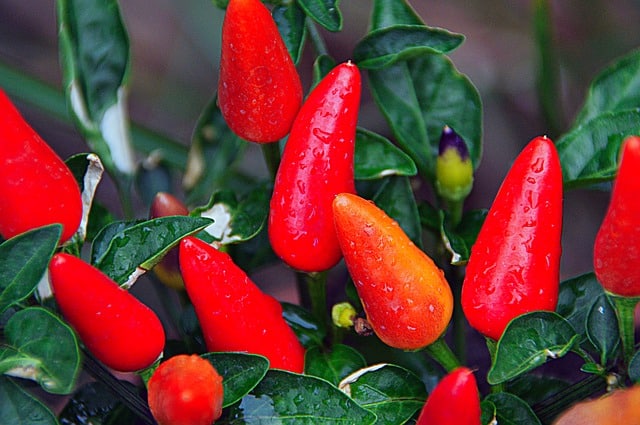
Nestled among the lush, verdant foliage of the rainforest, the Piri Piri (Capsicum frutescens) plant is a true culinary and botanical marvel, its small, fiery-hot peppers adding a distinctive, pungent kick to a wide range of traditional dishes and cuisines.
Native to the tropical regions of Africa and South America, the Piri Piri is a member of the Capsicum genus, which includes a diverse array of chili peppers known for their varying levels of capsaicin – the compound responsible for their characteristic heat. In the case of the Piri Piri, this compound is present in particularly high concentrations, making the small, red-orange peppers among the spiciest in the world.
Despite their fiery reputation, Piri Piri peppers have long been prized by indigenous communities for their culinary and medicinal properties. In traditional African and South American cuisines, the peppers are commonly used to add depth and complexity to a variety of dishes, from savory stews and marinades to spicy condiments and sauces. The Piri Piri’s pungent, smoky-sweet flavor profile also makes it a versatile ingredient, complementing a wide range of meats, seafood, and vegetables.
Beyond their culinary applications, Piri Piri peppers have also been used in traditional medicine to treat a variety of ailments, from digestive issues and respiratory problems to skin infections and pain. The high concentration of capsaicin in the peppers is believed to have anti-inflammatory, analgesic, and antimicrobial properties, making them a valuable natural remedy in many rainforest communities.
As the popularity of Piri Piri and other spicy ingredients continues to grow on the global stage, the preservation of the rainforest’s wild Piri Piri populations has become increasingly important. Through sustainable harvesting practices, the promotion of small-scale agroforestry systems, and the establishment of protected areas, we can work to ensure that this remarkable plant continues to thrive and provide its unique, flavorful bounty to both local and international culinary enthusiasts.
Walking Palm: The Enigmatic Ambulator of the Rainforest
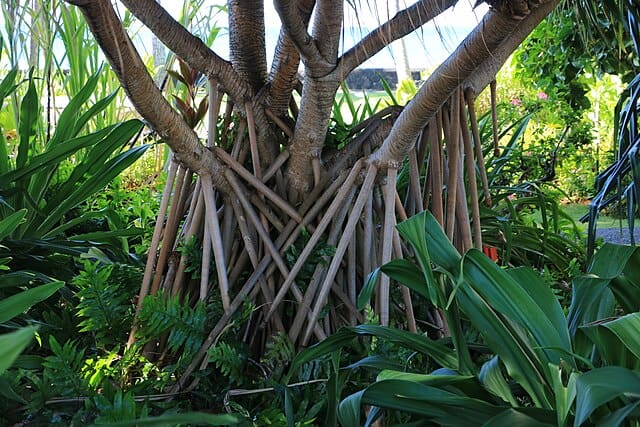
Amidst the dense, tangled undergrowth of the Amazon rainforest, a truly remarkable sight can be observed – the Walking Palm (Socratea exorrhiza), a tree that appears to be in constant motion, slowly but steadily “walking” across the forest floor.
This unique, palm-like tree has evolved a remarkable adaptation that allows it to literally uproot itself and move to more favorable growing conditions. As the Walking Palm’s trunk grows taller, its roots begin to emerge from the soil, forming a network of stilt-like structures that gradually lift the tree off the ground. Over time, the tree’s roots continue to grow and spread, pushing the trunk forward and allowing the plant to “walk” across the forest floor at a rate of up to 20 centimeters per year.
The Walking Palm’s ability to move is not only a fascinating evolutionary adaptation, but it also plays a crucial role in the rainforest ecosystem. By relocating to areas with more sunlight, nutrients, or moisture, the tree can ensure its own survival and growth, while also creating new opportunities for other plant and animal species to thrive in the newly vacated spaces.
Cumaceba (Lippia graveolens): The Aromatic Treasure of the Rainforest
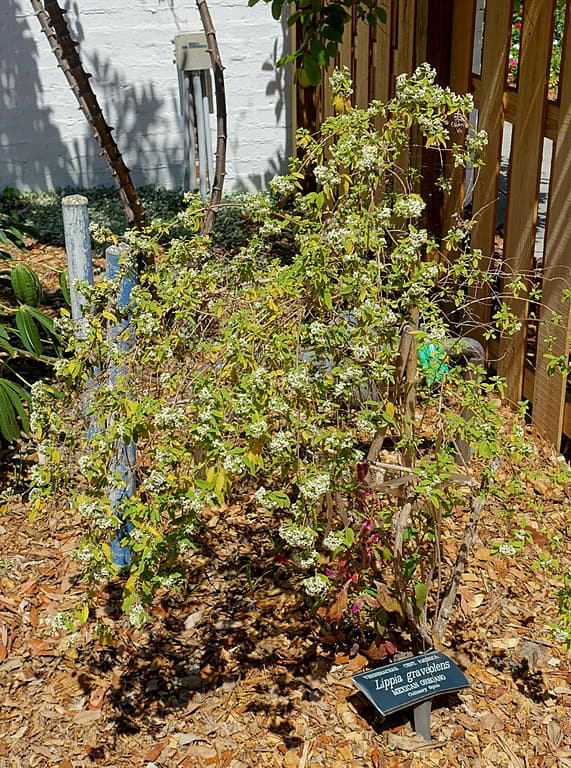
Nestled among the lush, verdant foliage of the Amazon rainforest, the Cumaceba (Lippia graveolens) is a small, unassuming shrub that packs a powerful aromatic punch. Also known as Mexican Oregano or Wild Marjoram, this fragrant plant is a member of the Verbenaceae family, and its distinctive, pungent leaves have long been prized by indigenous communities for their culinary and medicinal properties.
In the rainforest, the Cumaceba plays a vital role in the local ecosystem, providing food and shelter for a diverse array of insects, birds, and small mammals. The plant’s aromatic compounds, which include thymol, carvacrol, and limonene, not only contribute to its unique flavor profile but also serve as natural insect repellents and antimicrobial agents, helping to protect the plant from pests and pathogens.
Beyond its ecological significance, the Cumaceba has also been an integral part of traditional medicine and culinary practices in many rainforest communities. The plant’s leaves and essential oils have been used to treat a variety of ailments, from digestive issues and respiratory problems to skin infections and pain. In the kitchen, the Cumaceba’s robust, earthy flavor has made it a staple ingredient in a wide range of traditional dishes, from savory stews and marinades to fragrant herbal teas and infusions.
As the demand for natural, plant-based ingredients continues to grow on the global market, the Cumaceba has gained increasing attention and popularity. However, the preservation of the rainforest’s wild Cumaceba populations is crucial to ensuring the long-term sustainability of this remarkable plant. Through sustainable harvesting practices, the promotion of small-scale agroforestry systems, and the establishment of protected areas, we can work to safeguard the Cumaceba and the countless other botanical treasures that call the Amazon rainforest home.
Mountain Soursop (Annona montana): The Elusive Fruit of the Rainforest Highlands
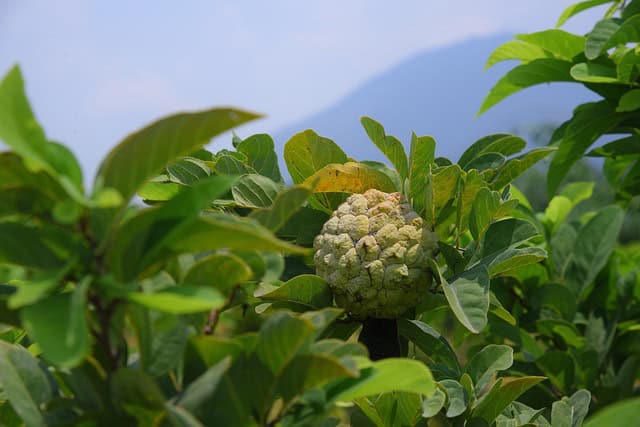
High in the misty, cloud-shrouded peaks of the Andes Mountains, where the lush, verdant rainforest gives way to a more rugged, alpine terrain, a truly remarkable fruit can be found – the Mountain Soursop (Annona montana).
A close relative of the better-known Soursop (Annona muricata), the Mountain Soursop is a small, evergreen tree that thrives in the cool, moist conditions of the high-altitude rainforest. Unlike its lowland counterpart, the Mountain Soursop has adapted to the unique challenges of its mountainous habitat, developing a more compact, hardy growth habit and a distinctive, oblong-shaped fruit that is smaller and less spiny than the Soursop.
Despite its elusive nature, the Mountain Soursop has long been prized by indigenous communities in the Andes for its exceptional culinary and medicinal properties. The fruit’s creamy, custard-like flesh is rich in vitamins, minerals, and antioxidants, making it a valuable source of nutrition in the remote, resource-scarce regions where it grows. The tree’s leaves and bark have also been used in traditional medicine to treat a variety of ailments, from digestive issues and respiratory problems to skin infections and pain.
However, the Mountain Soursop’s remote, high-altitude habitat and limited distribution have made it a challenging plant to study and cultivate, and its populations are increasingly threatened by the impacts of climate change, deforestation, and other environmental pressures. As a result, this remarkable fruit remains largely unknown to the wider world, its unique qualities and potential benefits largely untapped.
Monkey Brush (Combretum rotundifolium): The Vibrant Climber of the Rainforest Canopy

Winding its way through the lush, verdant canopy of the Amazon rainforest, the Monkey Brush (Combretum rotundifolium) is a true botanical marvel – a vibrant, woody vine that adds a splash of color and life to the otherwise shaded, understory environment.
A member of the Combretaceae family, the Monkey Brush is a fast-growing, climbing plant that uses its tendrils and hooks to cling to the trunks and branches of the surrounding trees, allowing it to reach the sunlight-dappled upper levels of the rainforest. Its small, glossy leaves and clusters of bright, yellow-orange flowers create a striking visual contrast against the deep greens and browns of the canopy, attracting a diverse array of pollinators, including hummingbirds, butterflies, and various insect species.
But the Monkey Brush’s significance extends far beyond its aesthetic appeal; it also plays a crucial role in the rainforest ecosystem. As a fast-growing, opportunistic plant, the Monkey Brush helps to fill in gaps in the canopy, providing shade and shelter for a variety of smaller plants and animals. Its nutrient-rich leaves and fruits also serve as an important food source for numerous rainforest inhabitants, from monkeys and birds to small rodents and insects.
In addition to its ecological importance, the Monkey Brush has also been valued by indigenous communities for its practical and medicinal properties. The plant’s leaves and stems have been used to create a variety of traditional crafts and building materials, while its sap and extracts have been used to treat a range of ailments, from skin infections and digestive issues to respiratory problems and pain.
Cupuaçu (Theobroma grandiflorum): The Decadent Delight of the Amazon
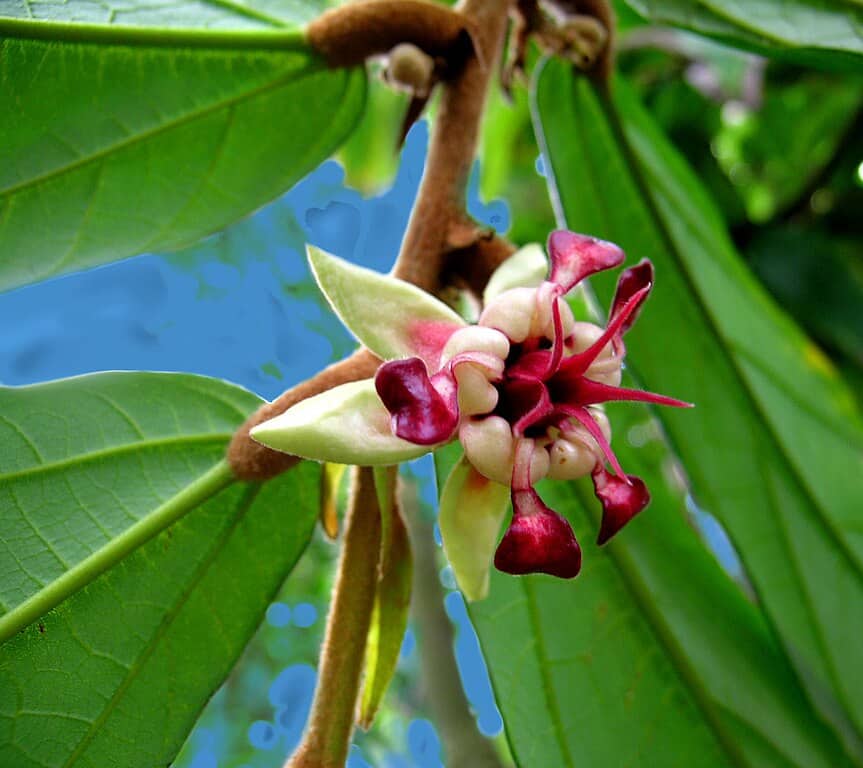
Deep within the lush, verdant heart of the Amazon rainforest, a truly remarkable fruit can be found – the Cupuaçu (Theobroma grandiflorum), a close relative of the beloved cacao plant and a culinary treasure that has captivated the taste buds of rainforest dwellers and global foodies alike.
A member of the Malvaceae family, the Cupuaçu is a medium-sized, evergreen tree that thrives in the nutrient-rich, humid conditions of the Amazon basin. Its large, oblong-shaped fruits, which can weigh up to 5 pounds, are encased in a hard, woody shell that opens to reveal a creamy, custard-like pulp filled with numerous small, edible seeds.
The Cupuaçu’s flavor profile is truly unique, blending notes of chocolate, vanilla, and tropical fruit to create a decadent, yet refreshing, taste experience. This exceptional quality has made the fruit a highly sought-after ingredient in a wide range of culinary applications, from juices, smoothies, and ice creams to baked goods, candies, and even alcoholic beverages.
But the Cupuaçu’s significance extends far beyond its culinary appeal; it is also a vital component of the rainforest ecosystem, providing food and resources for a diverse array of plant and animal species. The tree’s large, showy flowers attract a variety of pollinators, including bees, butterflies, and hummingbirds, while its nutrient-rich fruits and seeds serve as an important food source for numerous rainforest inhabitants, from monkeys and birds to small rodents and insects.




